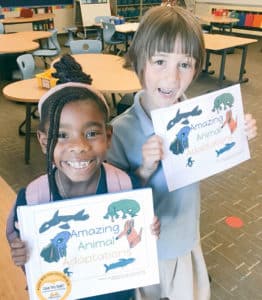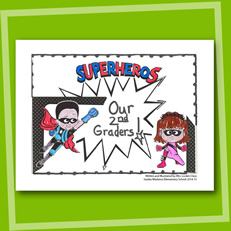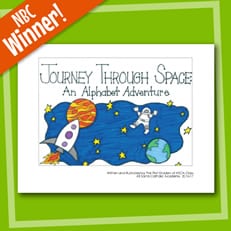
Take inspiration from these creative writing ideas, beloved children’s books, and more.
First Grade Writing: 3 Fun Class Book Cover Ideas with First Grade Writing Prompts
Create a Superhero Themed Classbook
PROJECT IDEA
A superhero-themed class book is always bound to be a hit with young students. Comic book superheroes are a huge part of pop culture today and chances are you have quite a few students who are huge fans of these characters they have seen in movies.
Ask your students to write about their favorite superhero to develop their descriptive writing skills. Alternatively, improve their persuasive writing skills by adding details about why they love their favorite superhero.
You can also ask your students to create their own superhero alter-ego.
You can also ask your students to create their own superhero alter-ego. Have students write a short scenario about how they would use their superpowers to save the day. Don’t forget to include how they acquired their superpowers. This will hone both their descriptive and narrative writing skills.
Making a Superhero Book Cover
It can be hard to fit in a drawing of all superhero characters on the book cover. Instead, have your students design their own superhero symbols and put those on the cover instead.
You can make a border for the logos and leave the center for the book’s title. This lets all students have an equal amount of space for their superhero symbol.
Ask each student to choose a shape for their superhero symbol. It’s best to show them some examples to help spark their imagination. Once they’ve chosen a shape and thought of a design, have them draw it around the title and color it in.
Use big block lettering for the book title to imitate the style of traditional superhero comics. If there is extra room, you can also draw sound effect bubbles to add even more of a comic book feel to your classbook cover.
Let your students color the letters and the sound effect bubble. Encourage them to use bright colors to continue the comic book theme.
Project Idea 2: Create a Classbook About Becoming an Adult
PROJECT IDEA
Not all kids see adulthood as a new adventure. Some kids dream of staying a kid forever. They want to spend their days playing with friends, doing fun activities in school, and living a carefree life. As a teacher, you can help students find the fun in growing up. It’s important to encourage your students to think positively about their future.
There are endless writing prompts that revolve around the theme of growing up. Have students write about their dream house, what they think the future would look like, or what they are looking forward to about adulthood.
A favorite writing exercise for first-grade students is to describe their dream job. Put a fun spin to the topic by having your students write a journal entry about a typical day as a doing their dream job and then adapt that entry into a page for the classbook.
Making a Future Career Themed Book Cover
Ask your students to think of an item that represents their chosen job. Draw this on the cover rather than a full-body representation of their future selves. This strategy, not only maximizes the cover space but also serves as an additional creative thinking exercise.
Guide your students by asking them questions about what they think the job entails or what they see professionals do in real life and on TV. You can provide suggestions on what to draw, especially if two or more students have chosen the same profession.
For example, if two kids want to be a police officer, one can draw the police cap while the other can draw a badge.
Write your book title near the top of the cover page. Go for a simple lettering style with only one color. If the title is too long to fit at the top of the page separate it into 2 sections. Put the first half of the title near the top and the other near the bottom, leaving space in the middle for student illustrations.
Let your students draw their dream job-related item in the provided space. Make sure their drawings aren’t too close together or overlapping.
Project Idea 3: Explore Outer Space with a Classbook
PROJECT IDEA
Unless you’re Ms. Frizzle with a Magic School Bus, you can’t take your students to outer space for a first-hand learning experience. What you can do instead is help them explore it through the written word and artistic illustrations.
Writing about a space topic that each student finds interesting, such as the Milky Way Galaxy or asteroids, helps them practice their informational writing skills.
If you want to take a more creative approach, ask your students to make up their own planet and to describe it in detail. This will help improve their descriptive and narrative writing skills.
Making an Outer Space Book Cover
An outer space creative writing prompt for your classbook allows students to be just as creative with the cover as they are in the prompts. Ask the students to draw planets, their version of a space shuttle, and more. Creating this book cover also gives students the opportunity to ask each other questions about what is being added to the cover and learn more about space from their peers.
Have students recreate our solar system or come up with their own galaxy that combines all of their ideas on one collective book cover.
Creating a collaborative classbook cover gives your students more opportunities to team up, socialize, and get to know their peers better.
To find more book-making and writing inspirations for you and your students, be sure to visit our online teacher’s lounge. Sign up for a free publishing kit today and help your students become published authors!








